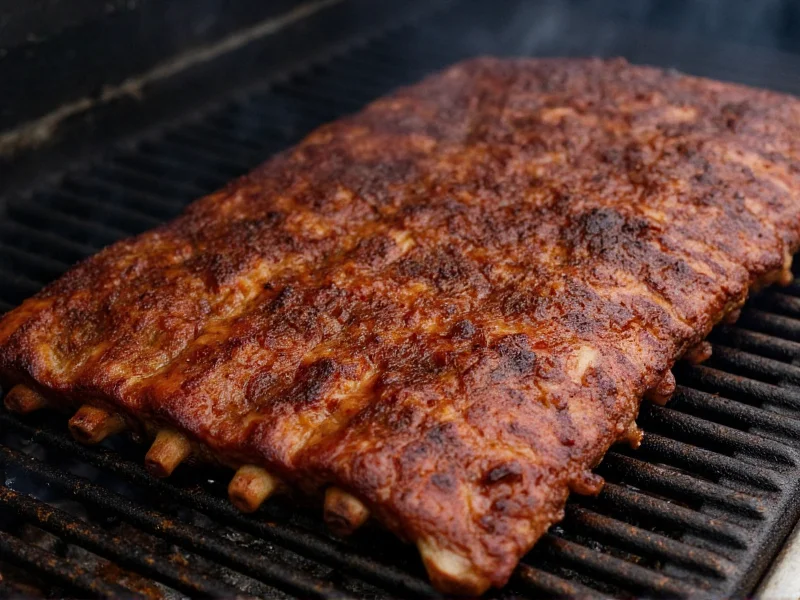Mastering the perfect smoke ribs temperature transforms tough cuts into fall-off-the-bone tender delicacies. Temperature control separates mediocre barbecue from exceptional results. This guide delivers precise temperature benchmarks backed by food science and professional smoking experience.
Why Temperature Matters in Rib Smoking
Unlike grilling, smoking relies on low-and-slow heat to break down connective tissues without drying the meat. The magic happens through collagen conversion to gelatin, which requires sustained heat within a specific range. Too hot, and ribs become dry; too cool, and they never reach the proper texture.
Rib Types and Their Temperature Profiles
Different rib cuts require slightly different approaches. Understanding these variations prevents common cooking mistakes:
| Rib Type | Smoker Temp Range | Target Internal Temp | Approximate Cooking Time |
|---|---|---|---|
| Baby Back Ribs | 225-240°F | 195-203°F | 4-5 hours |
| St. Louis Spare Ribs | 230-250°F | 190-200°F | 5-6 hours |
| Beef Back Ribs | 225-240°F | 200-205°F | 6-7 hours |
| Country-Style Ribs | 235-250°F | 195-200°F | 3-4 hours |
The Science Behind Smoke Ribs Temperature
Collagen begins converting to gelatin around 160°F, but the process accelerates significantly between 190-205°F. This transformation creates that signature tender texture. The stall phase—when evaporation cools the meat around 150-170°F—requires patience. Many beginners make the mistake of increasing heat during this phase, resulting in tough ribs.
Step-by-Step Temperature Guide
- Prep phase: Apply rub and let ribs sit 30 minutes at room temperature
- Smoker setup: Preheat to 225°F with quality wood chunks (hickory or apple)
- Initial smoking: Place ribs bone-side down, monitor ambient temperature
- Stall phase (150-170°F): Maintain steady heat, resist temptation to increase temperature
- Wrap decision: At 165°F, wrap in butcher paper or foil if desired (Texas crutch method)
- Final phase: Continue smoking until internal temperature reaches 195-203°F
- Resting: Tent with foil for 30 minutes before serving
Accurate Temperature Measurement Techniques
Proper thermometer placement makes all the difference. Insert your probe:
- Into the thickest part of the meat, avoiding bone
- Between bones for more accurate readings
- At multiple points to check for even cooking
Digital probe thermometers with dual sensors allow simultaneous monitoring of smoker ambient temperature and meat internal temperature—essential for maintaining the ideal smoke ribs temperature range.
Common Temperature Mistakes and Solutions
Even experienced smokers encounter these issues:
- Temperature fluctuations: Caused by frequent smoker openings or poor airflow. Solution: Use a quality thermometer and minimize lid openings.
- Uneven cooking: Results from improper rack placement. Solution: Rotate ribs halfway through cooking.
- Overcooked ribs: Occurs when internal temperature exceeds 205°F. Solution: Remove ribs at 203°F and let carryover cooking finish the process.
- Undercooked ribs: Happens when pulled below 190°F. Solution: Return to smoker until proper tenderness achieved.
Temperature Troubleshooting Guide
When ribs aren't turning out right, check these temperature-related issues:
- Dry ribs: Smoker temperature too high (above 250°F) or cooking time excessive
- Tough ribs: Internal temperature didn't reach minimum 190°F or temperature fluctuations during cooking
- Burnt exterior: Smoker temperature exceeded 265°F or ribs positioned too close to heat source
- Excessive smoke flavor: Temperature too low (below 225°F) causing smoke to penetrate too deeply
Advanced Temperature Techniques
For competition-level results, consider these professional methods:
- Reverse sear: Finish ribs at 350°F for 15 minutes to set the bark
- Temperature mapping: Track multiple points to identify hot/cold spots in your smoker
- Hold phase: Maintain 165°F for 2 hours to maximize collagen breakdown before finishing
Food Safety Considerations
While ribs become tender at 190°F+, the USDA minimum safe temperature for pork is 145°F. The extended cooking time at low temperatures eliminates pathogens through time-temperature relationships, not just final temperature. Always use a calibrated thermometer to verify doneness.











 浙公网安备
33010002000092号
浙公网安备
33010002000092号 浙B2-20120091-4
浙B2-20120091-4